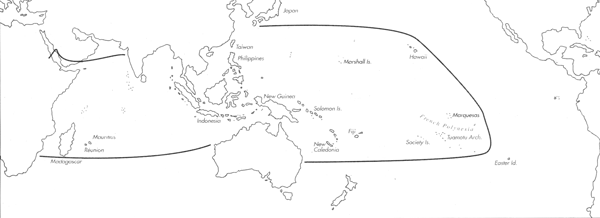
Skip Navigation Links
View access keys for this site.

Range: Entire Indo-Pacific.
Description: Moderately small to moderately large, moderately solid to moderately heavy. Last whorl conical to broadly conical; outline almost straight, somewhat convex within adapical fourth. Shoulder angulate, strongly to weakly tuberculate; tubercles occasionally obsolete. Spire of low to moderate height, outline straight to slightly concave. Larval shell of about 4 whorls. Postnuclear spire whorls tuberculate. Teleoconch sutural ramps flat, with 2 increasing to 4 spiral grooves. Last whorl with often variably granulose spiral ribs above the base, sometimes to centre.
| Shell Morphometry | ||
|---|---|---|
| L | 30-81 mm | |
| RW | 0.20-0.94 g/mm | |
| (L 30-70mm) | ||
| RD | 0.59-0.73 | |
| PMD | 0.87-0.93 | |
| RSH | 0.06-0.20 | |
Last whorl light olive or yellowish brown with narrow white spiral bands at centre and below shoulder that may be suffused with bluish-grey or rose. Base dark purple. Apex usually pink; larval shell yellow (Hawaii; Perron, 1981a). Later spire whorls and shoulder white, occasionally suffused with bluish grey or pale orangish violet. Aperture deep purple-violet behind a narrow orange-brown margin, with pale bands at centre and below shoulder.
Periostracum yellow-olive to greyish brown, moderately thick, translucent to opaque, with fine axial ridges and sometimes also with close-set spiral rows of tufts on last whorl.
Foot violet to brownish red, sometimes dark olive; mottled with dark brown to black and dotted with white; a darker sole may contrast with a light dorsum. White dots occasionally absent; black mottling may be so dense to produce a completely black appearance. On dorsum, black spots sometimes concentrated in a broad pre-marginal band, setting off an immaculate median zone from a narrow immaculate marginal zone; sole occasionally also with immaculate margins. Rostrum and tentacles red to dark purple, often mottled with black and dotted with white; white dots may be closely set at tip of tentacles. Siphon purple to dark red or dark olive, variably spotted or mottled with black, dotted with white; white dots variable in number, sometimes absent; black mottling often so dense as to produce a solid black siphon narrowly edged with red (Kohn, 1959a; Kohn, unpubl. observ.; Marsh, 1971; Chaberman, pers. comm., 1981; Fainzilber, pers. comm., 1987; Pearson, unpubl. observ.) (Pl. 74, Fig. 4; Pl. 77, Third row, right).
Radular teeth slender, with an adapical barb opposite a very weak blade; a group of small cusps just behind the barb and one prominent cusp 2/3 the length down the shaft; base with a distinct spur (James, 1980; Kohn, unpubl. observ.).
Habitat and Habits: Infrequently intertidal, common on subtidal coral reef platforms. C. lividus occupies diverse microhabitats: sand patches and pockets, coral rubble with and without sand, reef limestone with algal turf, bare reef limestone, dead coral heads, and beach rock (Kohn, 1959b, 1960, 1968b; Kohn & Nybakkan, 1975; Leviten & Kohn, 1980; Cernohorsky, 1964; Kilburn & Rippey, 1982; Tirard, pers. comm., 1989). C. lividus feeds on polychaetes of the sedentary families Terebellidae and Maldanidae and the errant Nereidae and Eunicidae as well as on enteropneusts (Kohn, 1959b, 1960, 1968b; Kohn & Nybakken, 1975; Reichelt & Kohn, 1985). Egg capsules flat, short-stalked, with crenulate margins, 6-17 x 6-12 mm (Kohn, 1961; Perron 1981; Kilburn & Rippey, 1982). Capsules fixed in rows by confluent basal plates to the underside of coral rocks or on bare limestone pavement. Each capsule contains about 2.000-3.300 eggs of 135-150 ┬Ąm diameter, suggesting a pelagic period of at least 28-29 days (50 days in Hawaii, based on in vitro observations; Kohn, 1961b; Perron, 1981; Perron & Kohn, 1985).
Discussion: C. lividus is very similar to C. sanguinolentus. They have often been synonymized, and their relationship remains somewhat uncertain. For comparison of C. lividus with C. sanguinolentus and C. moreleti, see the DISCUSSIONS of these species.

C. lividus Range Map
This section contains verbatim reproductions of the accounts of 316 species of Conus from the Indo-Pacific region, from Manual of the Living Conidae, by R÷ckel, Korn and Kohn (1995). They are reproduced with the kind permission of the present publisher, Conchbooks.
All plates and figures referred to in the text are also in R÷ckel, Korn & Kohn, 1995. Manual of the Living Conidae Vol. 1: Indo-Pacific Region.
The range maps have been modified so that each species account has it own map, rather than one map that showed the ranges of several species in the original work. This was necessary because each species account is on a separate page on the website and not confined to the order of accounts in the book.
Return to framed version (returns to search page)